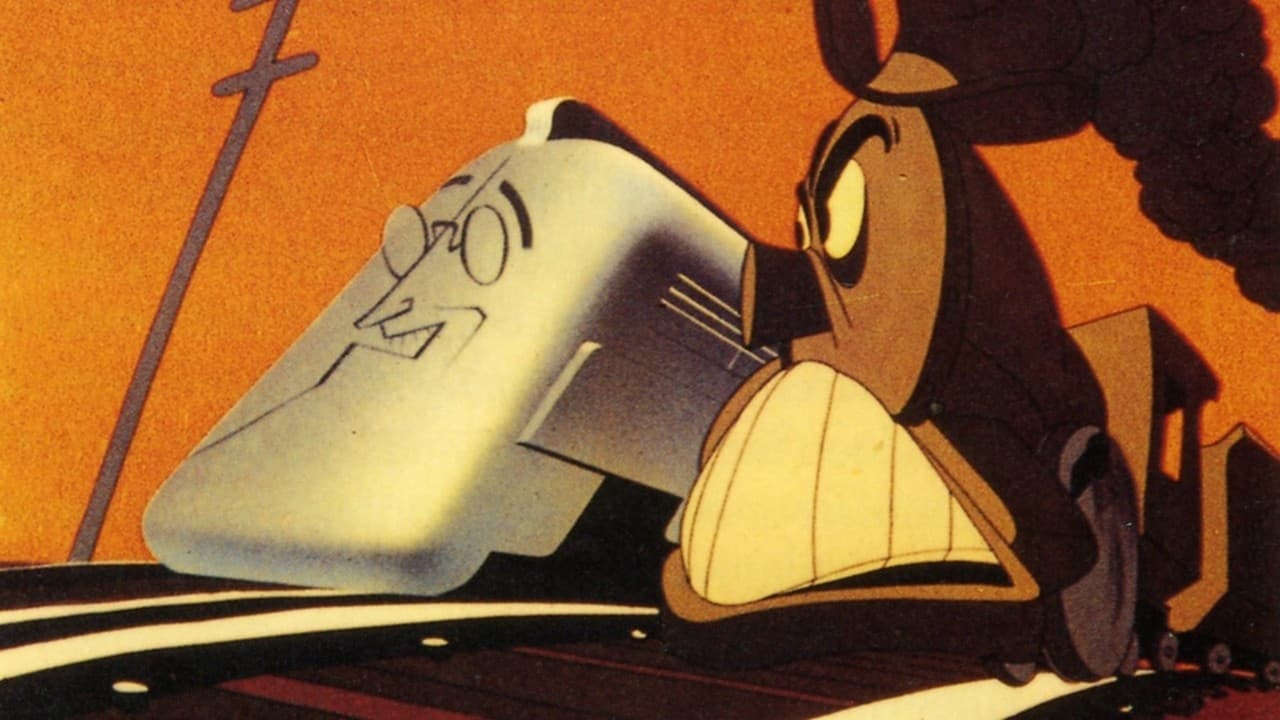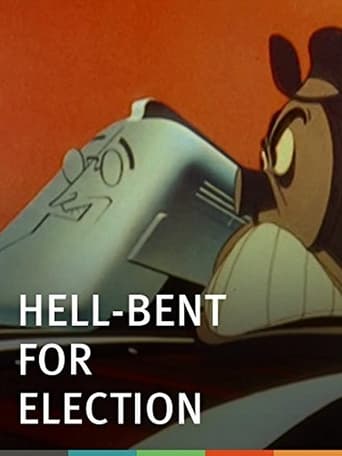



It's fun, it's light, [but] it has a hard time when its tries to get heavy.
View MoreInstead, you get a movie that's enjoyable enough, but leaves you feeling like it could have been much, much more.
View MoreIt's hard to see any effort in the film. There's no comedy to speak of, no real drama and, worst of all.
View MoreThere are moments that feel comical, some horrific, and some downright inspiring but the tonal shifts hardly matter as the end results come to a film that's perfect for this time.
View MoreDirected by Chuck Jones and produced by Steven Bosustow for what would later become known as UPA, Hell-Bent for Election was an attempt to convince certain workers not quite sure who to vote for president in 1944 to cast it for Franklin D. Roosevelt for a fourth term in order to help "win the war" (according to song lyrics written by E. Y. Harburg). Roosevelt is portrayed as a streamlined train that's running parallel to another train called "Defeatest Limited" that has every negative connotation associated with it as connecting cars. This was, I'm sure, effective propaganda for the time and probably ensured Roosevelt got even more votes even though he probably would have been reelected anyway since he did so well before during the previous Depression and the still-active World War II during this time. Well worth a look now for the fluid and stylized animation that would help define UPA during the late '40s and much of the '50s.
View MoreWhat an exhilarating piece of work this is! Hell-Bent for Election is by far the most enjoyable and effective example of campaign propaganda I've ever seen, a fascinating animated extravaganza that plays like an elaborate editorial cartoon come to life. This 13-minute film was a collaborative effort between the legendary Chuck Jones and the two men who would form the nucleus of UPA (the hippest cartoon studio of its day), Steve Bosustow and John Hubley. The goal of this particular project was the re-election of President Franklin D. Roosevelt in 1944, and the artists involved gave it everything they had: the visual style combines the fluid, funny character work found in Jones' Warner Bros. classics with the cubist, angular graphics UPA would soon help establish as the dominant post-war style. The script is sharp, full of puns and topical references that might bewilder viewers who aren't well-versed in the political history of the 1940s. But even if you don't catch all the jokes, there's no denying that the campaign song that closes the film is incredibly catchy, and may have you singing along by the end. The lyrics were written by E. Y. ("Yip") Harburg, who wrote the words for a number of songs that can safely be called immortal, including "It's Only a Paper Moon" and "Over the Rainbow."The story concerns a railroad worker named Joe whose job it is to throw a switch so that one of two trains -- but only one -- can proceed to the White House on a single track. The trains represent the candidates of the two main parties, and this is where the political analogies are especially clever: FDR is personified as a slick, modern diesel train, the Win-the-War Special no less, while the opposition is depicted as a tired, wheezing, decadent locomotive called the Defeatist Limited. There is no attempt to make the "Republican" train resemble the GOP candidate, Thomas E. Dewey, but the film-makers were careful to show this train pulling a lot of ugly freight loads, such as the Business as Usual Sleeper and a Jim Crow car representing institutionalized racism. (This last accusation was pretty nervy, however, since so much Jim Crow legislation of the era was sponsored and passed by conservative Southern Democrats.) As these two trains approach the junction, meanwhile, Joe is pestered by a wicked little politician who attempts to distract him with flattery, blather, and booze from a bottle labeled "Campaign Champagne – No Proof." A powerful cigar offered by this scoundrel lulls Joe into a heavily medicated, hallucinatory nightmare state, but there's little doubt he'll manage to snap out of it and do the right thing in the nick of time.I think it's worth pointing out that depicting FDR as a powerful train was a brilliant, almost subliminal transformation of his personal misfortune, i.e. his paralysis, into an asset. President Roosevelt was almost never photographed in his wheelchair, and according to people of my parents' generation the true extent of his disability was not widely understood, but certainly most Americans were aware that he could not walk without assistance. To depict him here as a grinning, confident diesel train, happily barreling down the track towards certain victory, was a stroke of genius.In any event, a written description doesn't do this cartoon justice, nor does a single viewing. It's a dazzling display of the animator's art as well as brilliant political propaganda. From what I gather the film was originally shown not in regular theaters but at labor meetings, rallies, Democratic Party conclaves, etc. I'm sure it was a very effective means of rallying the troops, especially with that great song at the finale. Even today, many decades later, you may feel charged up and ready to go out and vote when it's over.
View MoreThis cartoon is a very effective piece of propaganda and demonstrates the strength and effectiveness of animation as tools for generating propaganda. The initial project of UPA studios, it was undertaken because the outcome of the Presidential election was in doubt in 1944 and a great many people saw the continued presence of FDR in the White House as vital to the prosecution of WWII.As has been said before, "Anything can happen in a cartoon" and that freedom allows for images much more striking and powerful than words alone can be to be used to make the point forcefully that Roosevelt was far and away preferable to Thomas Dewey. What makes this propaganda is the fact that, while undoubtably FDR was best suited to continue the fight, if for no other reasons than continuity, Dewey wouldn't have been nearly as bad as this indicates he would have been. The most telling attack, the "Jim Crow laws" car on the Dewey train conveniently overlooks the fact that, in the 1940s, the South was largely in the hands of the Democrats and "Jim Crow" laws received broad support from both parties. Propaganda is exaggerated for effect, for the purpose of motivating people, often out of fear, to a particular course of action. This is a most effective piece of propaganda.You can see both the fine hand of Chuck Jones and John Hubley all over this cartoon. It also shows what would later become known as the UPA style in its infancy. Though obviously quite dated (by its nature, it would have to be), this holds up very well and is well worth seeing, particularly for those with an interest in politics and/or animation. Well worth getting. Most highly recommended.
View MoreChuck Jones moonlighted with the artists of what would eventually become UPA to make this excellent piece of election propaganda. It was funded by the United Auto Workers to help re-elect Franklin Roosevelt. In the cartoon Roosevelt is caricatured as a streamlined train, while Thomas Dewey is the Defeatist Limited. A southern senator tries to lure Joe Worker to fall asleep at the switch and so allow Dewey to win. The animation is somewhat stylized with pleasing graphics. Probably one of the few, if not only, cartoons to be so overtly political (one of the Dewey train cars is labeled "Jim Crow"). I recommend it for any fan of animation history.
View More